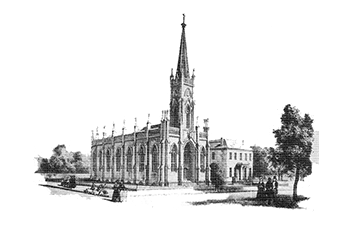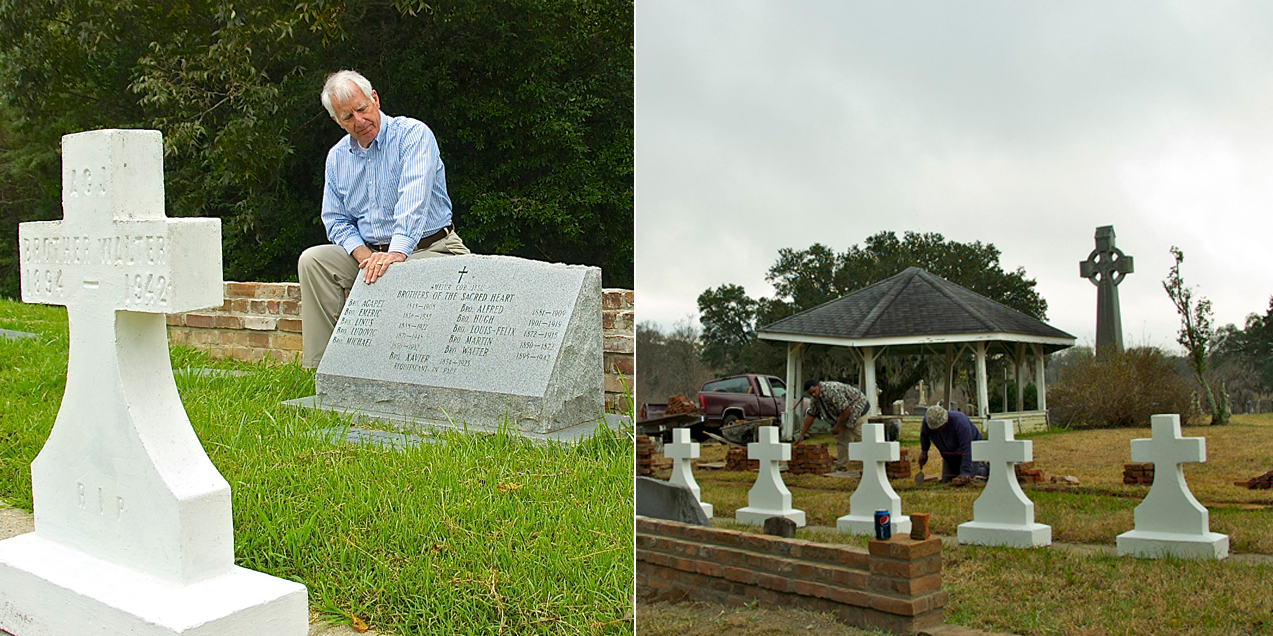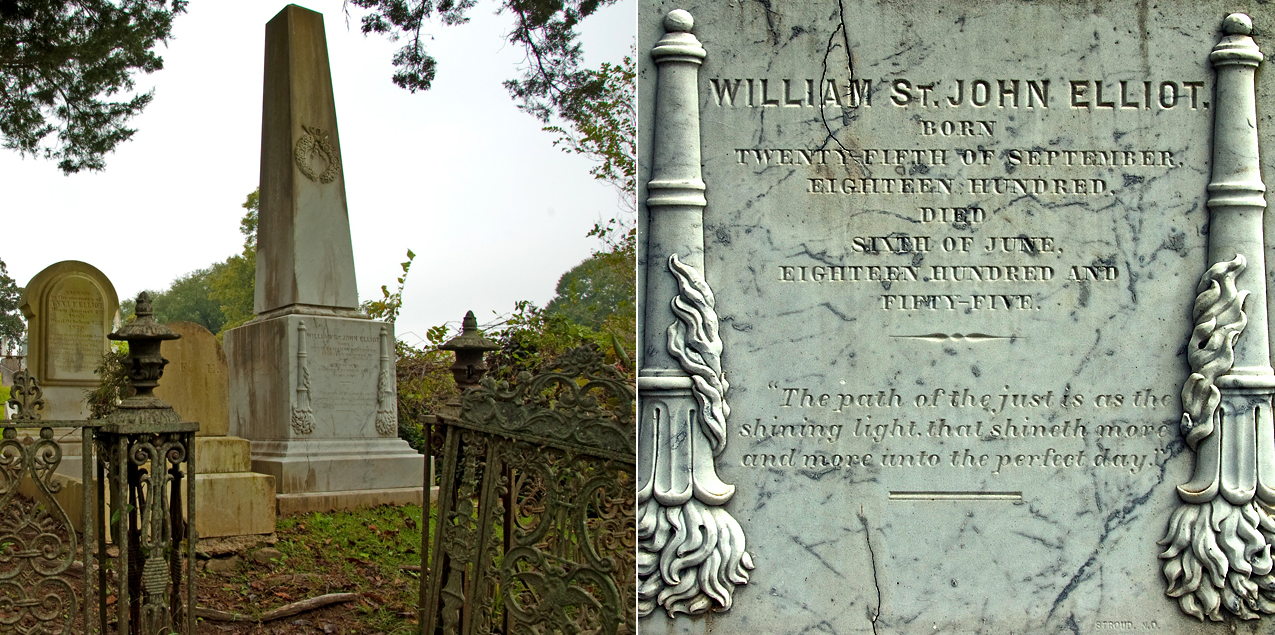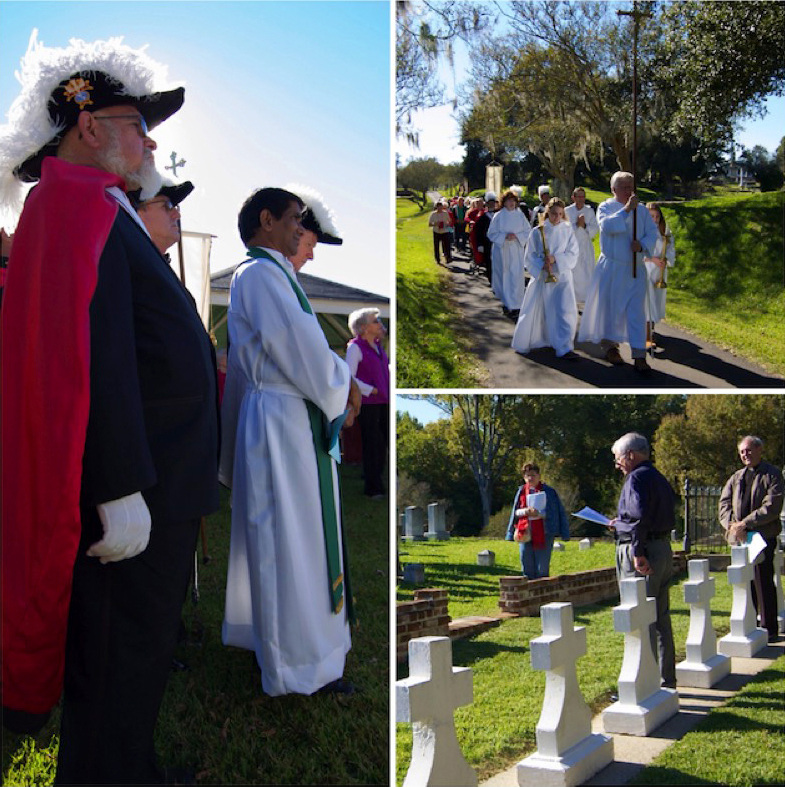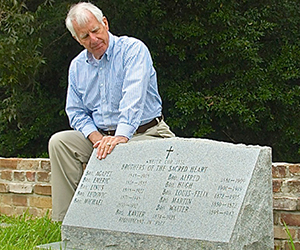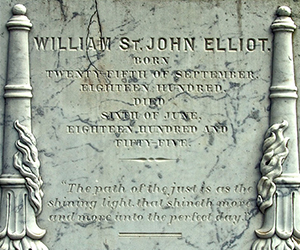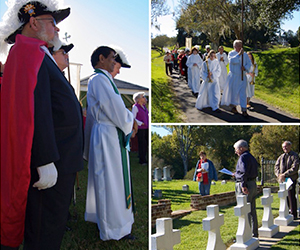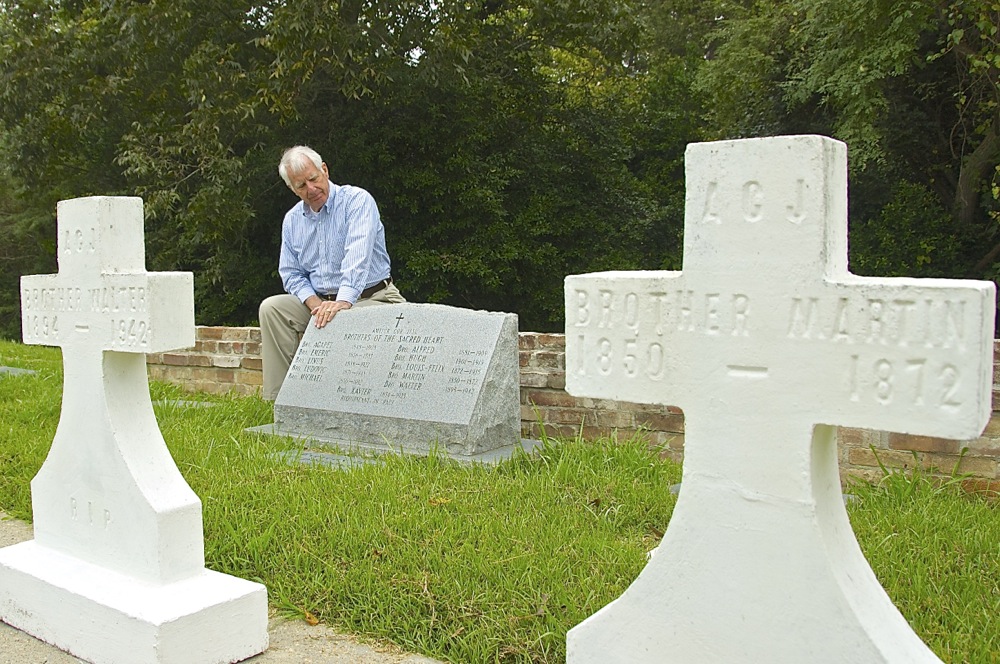
All Souls Day 2013
Remembering the Brothers of the Sacred Heart in Natchez. Donald Shadnaigle poses in the brothers cemetery plot on Catholic Hill, Natchez City Cemetery.
The Brothers of the Sacred Heart in Natchez 1865–1966
The Sacred Heart Brothers were founded near Lyon, France, in 1821 by Father Coindre to care for homeless or abandoned boys. The first brothers arrived in the United States at Mobile in 1847 to take charge of a home for orphans and a school.
The Sacred Heart Brothers brought with them to the United States a strong peasant tradition as well as a dedication to education. The brothers’ ranks always included strong, humble, pious men with little formal education who devoted their lives to farm work at several orphanages, including Natchez. These farm brothers were “rugged men, honest toilers, and most scrupulous in the practice of poverty for they had to serve and skimp their hard earned pennies so that their poor charges could get a sufficient sustenance.
On July 21, 1865, Bishop William Henry Elder entered into an agreement with Sacred Heart Brother Athanasius to send three brothers to staff the Cathedral boys’ school in Natchez. They were to teach a primary school plus commercial subjects and higher mathematics. On November 1, 1865 the first three brothers - Florimond Pauble, Vincent McLaughlin, and Joseph - were sent to Natchez. Each teaching brother was to receive an annual salary of $300.
In 1854, William St. John Elliott bequeathed D’Evereux Hall and its grounds to the Catholic Church to establish a male orphanage. Mrs. Ann F. Elliot, a non-Catholic, made generous arrangements to buy back the reversionary interest from Bishop Elder and the trustees for $27,000. The money was used to purchase 35.19 acres on which to establish an orphanage. The diocese opened an orphanage in 1860 in a small frame building on a plot of land on Aldrich and Pine streets in Natchez. In 1866, the cornerstone for the D’Evereux Hall Orphanage building that remained through 1966 was laid.
In December, 1865, Brothers Louis Joseph Larre, Isaiah Sere and Benedict arrived in Natchez to take charge of the twenty orphan boys who resided in this small frame building.
Classes in the school basement began on November 6. By the close of the first year, 130 boys had been enrolled. The school was a free school supported by the congregation. Non-parishioners were also admitted at a set tuition. Protestants as well as Catholics attended the school.
The following year, a 23-year old Irish born Brother Stanislaus Keating arrived in Natchez as the Cathedral School Director; enrollment increased to 180. This dynamic educator made a lasting impression on the city during his three-year tenure.
On July 1, 1866, the cornerstone of a new two-story brick school building was laid on the property across the street from the cathedral. The brothers moved into the new building on September 23, 1867.
The new school building was a solid, two-story brick structure. The basement was used as meeting rooms, while the first floor was divided into “elegant class rooms,’ and the second floor consisted of a large hall with a stage.
The Cathedral boys’ school began a decade of decline after Brother Stanislaus’ transfer to New Orleans in 1869 to found St. Aloysius College. On several occasions, Bishop Elder asked for another director like Brother Stanislaus “who could wake up the institution from its listlessness.” The brother provincial replied that this would require a separate brothers’ residence which the bishop could not afford and the parish was unwilling to support.
It was in Natchez that the Brothers first wore cassocks in the United States. Brothers Stanislaus Keating and Felician Deaclard were instrumental in introducing the change on July 16, 1868, when the brothers first wore the cassock to church, replacing the knee-length frock coat called a soutanelle.
The brothers were also instrumental in further solemnizing the feast of Corpus Christi by requesting the procession that became an annual service at D’Evereux Hall.
During their first year in Natchez, the brothers lived in a small building donated by Mrs. Charlotte Moore near the bishop’s residence. From 1866 to 1892, both the school and orphanage brothers lived at D’Evereux Hall; the school brothers had their noon meal brought by one of the orphans. These living arrangements were unsatisfactory and there were frequent tension and misunderstanding between the school and orphanage brothers. The orphanage brothers continued to reside at the facility until its closing in 1966.
In 1892, the parish purchased the former Natchez Clubhouse on Main Street next to the school yard for $5,500. For the next twelve years, the brothers resided there.
On July 1, 1903, ground was broken for a new brothers’ residence across from the bishop’s house; the old residence was leased to Jim Salvo for a restaurant.
In 1922, a large building at the corner of Union and State Streets was purchased and remodeled as “a first-class residence for the brothers,” while their former home was converted into additional classrooms.
The brothers lived a frugal existence at both the school and orphanage. At the orphanage, they provided a formal education as well as vocational training and experience to the young boys. The brothers and boys worked together to raise cows and chickens as well as grow cotton, corn, hay, beans, and potatoes.
The brothers remained in charge of the two institutions - school and orphanage - until 1935. Bishop Gerow, because of lack of funds during the depression years, “was forced to let the brothers go and combine the boys’ and girls’ schools under one management of the Daughters of Charity.
The brothers remained at the orphanage for another thirty-one years. Brother Dacian LeBlanc was the orphanage’s last director. Like his predecessor, Brother Aquinas Vanderhoeven, he was a trained educator with a graduate education degree from L.S.U. and twenty-nine years of teaching and administrative experience. The physical presence of the Brothers of the Sacred Heart in Natchez ended in 1966 but the effects of their presence will always remain.
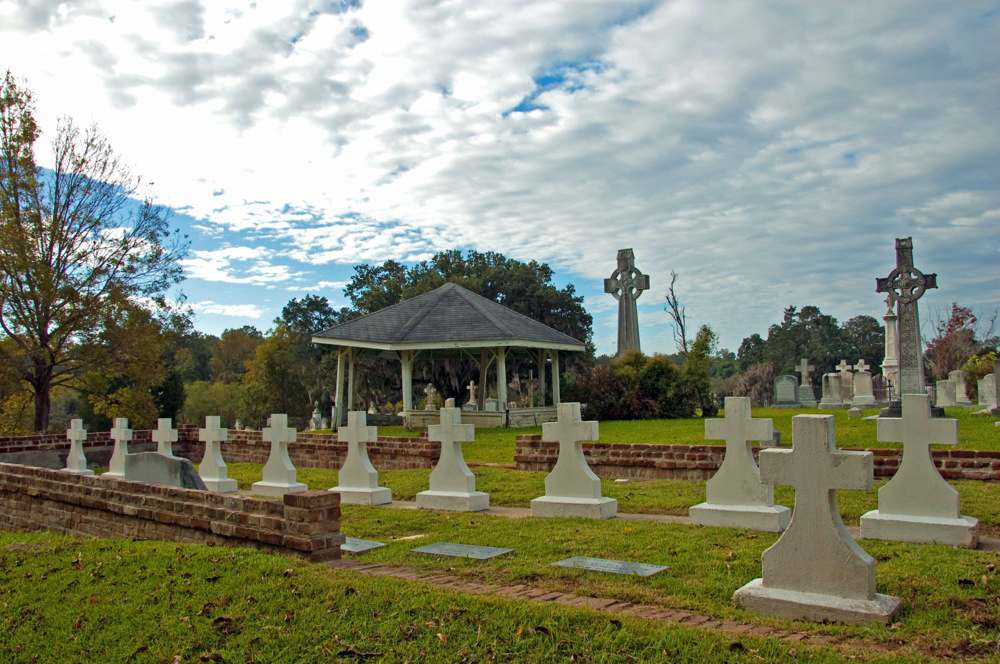
Brothers of the Sacred Heart cemetery plot on Catholic Hill, Natchez City Cemetery
Click images to enlarge with captions.
Brother Ludovic Wester was the last brother to die in Natchez. Brother Ludovic’s most significant accomplishments took place during his first term as superior at D’Evereux Hall (1912-1918). He standardized the school curriculum, established a sound financial base for the institution, and modernized the farm and dairy. The production and sale of milk, cotton, corn, hay, beans, and potatoes were made more efficient and profitable. Bishop Gunn once remarked that Brother Ludovic could make a dollar go farther than any person he had ever know. Brother Ludovic passed away on October 23, 1948 due to poor health.
Brother Michael Beaumont came to D’Evereux Hall in 1876. He remained here as tailor and infirmarian for the next fifty-six years except for two brief assignments in Mobile. A crippled leg which necessitated the life-long use of a cane did not incapacitate or sour him, but rather gave him a special sympathy for the young orphans. He was a familiar sight to Natchezians, hobbling to early Mass each day, with a cheerful greeting and a few moments of “sociable companionship.” Brother Michael worked faithfully in his tailor shop until the evening before his death on December 18, 1932. He was 82 years old at the time of his death.
Brother Xavier Thompson taught first and second grades for twenty-one years in Indianapolis. Later he taught, perfected, and worked in various manual activities in the South. Shunning attention of any type, Xavier rarely took part in conversations and moved about so silently that his comings and goings were hardly noticed. His unselfish devotion to duty and his total detachment from material possessions made a powerful impression on Monsignor John Pendergast, vicar general in Natchez, who praised him for his religious poverty. Brother Xavier passed away in 1923 at the age of sixty-nine.
Brother Linus Berard began his assignment to Natchez in 1913 as a gardener. Brother Linus helped transform the old vegetable garden into a successful farm and dairy, eventually gathering a thoroughbred herd of over seventy-five cattle. He was a familiar sight, trudging out of the city to the nearby pasture with his faithful dog or setting out on his favorite pastime - a hunting expedition through Natchez’s rich game preserves. Brother Linus passed away on July 13, 1922 due tuberculosis.
Brother Hugh Stutzman, a Cathedral student, entered the Brothers novitiate at the age of fifteen. While still a scholastic, he developed tuberculosis and was transferred first to Mobile and, at his father’s request, to Natchez, where he spent his last days. Brother Hugh died on January 30, 1919 at the age of eighteen.
Brother Emerick Faure began his teaching at Frankfort, KY. He later taught in Vicksburg and Natchez. While in Natchez as prefect, he contracted tuberculosis and died from it at the young age of twenty-nine. Of a quiet disposition, Brother Emerick was always punctual and faithful to his religious exercises. In a circular announcing his death to the brothers, Brother Athanasius, provincial, wrote of him: “He was a model of patience, meekness, and humility."
Brother Walter Holubovich was first assigned to Natchez from 1934-1937 where he became master of all trades, prefect, nurse, gardener par excellence. He was again assigned to D’Evereux in 1940. He died, in Natchez, at the age of 47 on January 12, 1942 while working in his garden.
Brother Martin – no information avaliable
Brother Agapet Veyssel was a quiet and capable worker. Agapet never looked for praise. He was totally devoted to religious life. He was a holy man of prayer who lived a rigorous life without complaining. Most of his life was spent serving the orphans in Mobile and Natchez as cook. Brother Agapet died at the age of sixty-seven, in the year 1908 of blood poisoning.
Brother Alfred Sarruc was a capable and methodical teacher who believed in strict discipline. Alfred was also an enthusiastic and very hard worker. During the rebuilding of St. Stanislaus at the Bay following the fire of 1903, many hard demands were placed upon the brothers. Alfred was overcome by fatigue, but continued to push himself beyond the point of recovery. Extreme exhaustion led to his early death on February 1, 1909 at the age of 28.
Brother Louis-Felix was transferred to Natchez in 1909 where it was hoped that outdoor exercise and a drier climate would improve his health. He raised chickens, helped with the financial books, and assisted with household chores until illness confined him to bed for the two years before his death. His curiosity never waned and he maintained a cheerful disposition to the last. He died on June 18, 1914 at the age of 42 from tuberculosis.
D’Evereux Boys Buried On Catholic Hill
John Sullivan January. 7, 1863
Andy Dwyer September. 19, 1910 10 years old, tubercular peritonitis
Patrick Hammill December. 6, 1873 14 years old, typhoid fever
James Thompson September. 2, 1872 13 years old, congestive fever
John Campbell November. 2, 1871 17 years old, yellow fever
Frank Brophy October. 17, 1871 10 years old, yellow fever
John Carroll March. 25, 1872 16 years old, typhoid pneumonia
James Morgan September. 5, 1924
